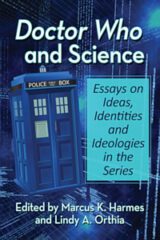No other TV series can boast with presenting the most exciting, thrilling and colorful adventures for decades and also featuring the most unusual protagonist, namely the Doctor(s), aka the Time Lord in the English TV program Doctor Who.
 It was first launched in 1963 by BBC One and, with some interruptions, is still running today. Where else will time travel meet adventure, plans to conquer or destroy Earth, attacks of either Cybermen, Daleks or other alien forces, meetings with the world’s greatest thinkers, artists and inventors from all periods, frequent encounters with dinosaurs and intruders of all kinds?
It was first launched in 1963 by BBC One and, with some interruptions, is still running today. Where else will time travel meet adventure, plans to conquer or destroy Earth, attacks of either Cybermen, Daleks or other alien forces, meetings with the world’s greatest thinkers, artists and inventors from all periods, frequent encounters with dinosaurs and intruders of all kinds?
The Doctor, who thanks to the concept and vague technology of regeneration in his time-space-traveling facility TARDIS, an old-fashioned police box, over the years appeared in different incarnations/reincarnations, resulting in altogether thirteen actors who played his part. Until 2017, the Doctor was male, then Jodie Whittaker as the first female incarnation, and the “Thirteenth Doctor” was introduced, a fact that is discussed at length in the title at hand.
Thousands of characters, aliens, machines, minds and combinations of such appeared during the almost 60 years of series history. One character, however, surfaced more or less regularly and repeatedly. A personality who represents knowledge and advancement, no matter on what planet, time or dimension the series action takes place or the TARDIS materializes: the scientist. “Scientists are common in Doctor Who, because its serials frequently engage with science-related themes or threats, and scientist characters put a human face on the ideological stance involved. Scientific institutions, too, feature as a setting for Doctor Who, enabling an exploration of science’s impact and meanings for society.”
Editors Marcus K. Harmes and Lindy A. Orthia, who provide the introduction, conclusion and essays of Doctor Who and Science, have selected fifteen authors to accomplish this book. They come from the UK, Canada, Australia and the United States and are experts in various disciplines, such as astrophysics, science communication, biology, modern history, psychosocial studies, American Sign Language, translation technologies, philosophy, sociology, physics, and media studies.
And naturally, they are familiar with the program: “Realistically, academics tend not to write about Doctor Who unless they are also fans or at least highly engaged viewers. The contributors to this volume … have applied the same scrupulous rigor in these essays as we would in other works.”
So topics like the overall performances of mankind as seen by the Doctors throughout the centuries, the benefits of regeneration for Time Lords, the emphasis on energy utilization and optimization throughout the series, the many links and journeys to the moon throughout the seasons, the real significance of dinosaurs who appear rather often or the emphasis on female scientists and the first female Doctor fill the volume.
Probably the two most intriguing texts in this book are “Exploring the Science Behind Multilingual Translation” and “Victorian Scientific Enquiry on Old and New Series Doctor Who” by Mark Halley/Lynne Bowker and Catriona Mills, respectively.
The popularity of the Doctor and the scientific theories and educational benefits that have accompanied the series for decades is extraordinary, there still is a very strong fan base. As one result, for 2022, a huge “Doctor Who Worlds of Wonder: Where Science meets Fiction“ exhibition is scheduled to tour the UK and other countries. (A similarly strong interest in the sciences, mostly physics, astronomy and forms of communication also was promoted by another popular science fiction show, namely the Star Trek franchise.)
Doctor Who, apart from being a very entertaining and charming show, had the priceless side effect to stir a certain curiosity in science in young adults and children alike, who went on to study such disciplines later in life and thus making somewhat boring topics attractive and even thrilling. “Its relevance to real world science – whether to the social, cultural, political, ideological, and ethical aspects of science or to our understanding of space, time aliens, biology, chemistry, mathematics and physics – is apparent when considering the program’s impact on its viewers.”
All in all, Doctor Who and Science is an interesting read, although it is not the first lengthy publication on the topic. Some essays here remain a bit unclear in their key conclusions, while others seemingly are trying to filter the series through an imaginary gender ideology or would like to force unnecessary obedient political correctness on certain characters or specific episodes broadcast long, long ago. This is a bit weird, as all thirteen Doctors can be described as open-minded analytical thinkers, most of them were pragmatic characters and not ideologists.
Review by Dr. A. Ebert © 2021
Marcus K. Harmes and Lindy A. Orthia (eds.) Doctor Who and Science. Essays on Ideas, Identities and Ideologies in the Series. McFarland, 2021, 195 p.
